danbricklin.com/log
|
||
|
|
Starting February 11, 2002
802.11 vs. tearing up walls, Handspring Treo 180 review, Observations from a weblogger, Demo 2002, Better permanent URLs in this log!
11Feb02-02Apr02
2002_02_11.htm
|
|
|
802.11 vs. tearing up walls [link]
I've been using 802.11b quite successfully at home to connect my laptop and a desktop PC to my router. (You can read my report about it from early last year.) I finally decided to put a few real 100Base wires between the 1st floor cable modem and my 3rd floor office and move the router and access point up there. I called in the company that originally wired my house when I moved in years ago. The house is a 100-year old Victorian. After a site visit, we determined that the easiest and best way to do it, and one that left room for expansion, was to put a simple plastic pipe down the side of the house behind the downspout. That way I could easily add future wires/fibers from my office to the basement, and from both of those to the rest of the house.
Since the access to the 3rd floor was near the 200-amp main electrical wires, this was clearly something I didn't want to do myself. I signed a fixed price contract for several hundred dollars -- ouch! It turned out, though, that almost everything that could go wrong did. From cracking plaster to broken test equipment, it took well over a day of two people to complete. The new cables, though, do seem to work well and the job does look "professional".
    Where the conduit would enter the attic, installed conduit waiting for cable, pulling cabling in the attic surrounded by insulation, old plaster and new outlet before finishing
What to learn from this? Adding connectivity, even simple connectivity, to existing buildings is very expensive, time consuming, and not likely to be popular. "No new wires" solutions like 802.11 are the only way we'll be able to deploy things that require connectivity on a large scale quickly. An access point/router plus an 802.11b PCMCIA card totals about $260, a lot less than an electrician for a day and a lot less than a new "Internet enabled" cell phone like my Treo. That's why 802.11 is so popular ($1.2B in wholesale equipment sales last year, with lots from "low-end or SOHO" according to Dell'Oro Group).
Treo review Parts 2 and 3 [link]
I've finally finished my review of the Handspring Treo. I've added observations about the phone and using it for email and web browsing in Part 2. In Part 3, I've listed and commented upon a few other reviews that have appeared on the web, and talk about why the Treo is a platform and other overall impressions.
Start with "Handspring Treo 180 Review, Part 2".
Part 2 delayed [link]
I didn't receive my production Treo 180 until Monday afternoon, so it probably won't be until sometime next week when I can get the next part of my review done. I'm trying to get enough time of actual, regular use to comment knowledgeably. As a PDA, I continue to like the device very much. The keyboard is even usable with a Band-Aid on my thumb (dumb minor accident while washing the dishes).
Handspring Treo 180 review: Part 1 [link]
I've had a preproduction Handspring Treo 180 combination PDA/cell phone/keyboard for a few weeks. I've also ordered a final, production unit which should arrive by next week. There are many aspects of this device that are important to understand if you want to see where handheld computing is going. I just posted the first part of a review, covering the physical device, the keyboard, and the applications. Next week I'll comment on the phone and Internet usage. Finally, I'll tie it all together.
Read "Handspring Treo 180".
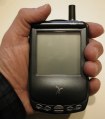 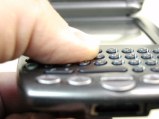 The Treo 180 in my hand, finding out why the keyboard works even if you have big fingers
Bottom line? I like it very much and bought one with my own money to be my main phone and PDA. The keyboard is the result of a lot of development work and it shows.
Observations from a weblogger [link]
I've put in my two cents about weblogging in a new essay. Read "Observations From a Weblogger".
Demo 2002 album done [link]
I finished my report from Demo 2002 and posted it last night. There are quite a few interesting things, including more pictures of Bill Gross' robot, Space Data's cellular repeaters in weather balloons, an LCD display with depth, and more.
See: Demo 2002 Album.
  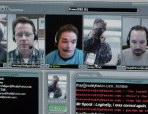 Releasing a Space Data balloon, Actual Depth display, TeamView video conferencing
More Demo 2002 [link]
My second major post from Demo 2002 has pictures from Monday afternoon's presentations. See Demo 2002 Album.
Demo 2002 [link]
I'm putting together a web photo journal about the Demo 2002 conference. I'll put most of the pictures and comments there instead of here on this web log. Each time I make a major update I'll mention it here. (Not more than a couple of times a day...)
Read: Demo 2002 Album.
First post: The day before and the first presenters. (If you like playing with robots, you much check out what Bill Gross presented from Evolution Robotics, a software platform for controlling robots with a neat breadboard to try it on -- $995 plus your Linux laptop.)
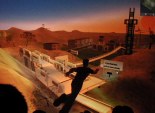  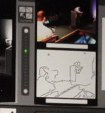 Linden World; Chris Shipley; Bill Gross' robot's screen showing back of his head and edge detection
Read: Demo 2002 Album.
Better permanent URLs in this log! [link]
After one too many requests from readers, I'm finally biting the bullet and making a more permanent-link-friendly archive. Rather than wait until I roll things off the home page to have my postings accessible with a permanent URL, I'm starting to keep the permanent copy up to date all the time. I'm also putting in anchors for each post in the archive.
I'm still using Trellix Web/CuteSITE Builder to author this log. It does not do the archiving automatically. I'm going to do it by just recopying the home page body material to the archive page each time I post, and then put in an anchor link. Hopefully I'll be able to keep the typo-corrections the same in both. (I, or a reader, often find typos after I post that I then correct.) My posting rate is somewhat lower than it was when I started this log and made the decision not to keep two copies, so I think the added work won't discourage me from posting. Also, some of the quick stuff related to discussions with Bob Frankston and David Reed have moved to SATN.org, which is authored with Blogger. Blogger automates the archiving and permanent-anchor work.
|
||
|
© Copyright 1999-2018 by Daniel Bricklin
All Rights Reserved.
|
||